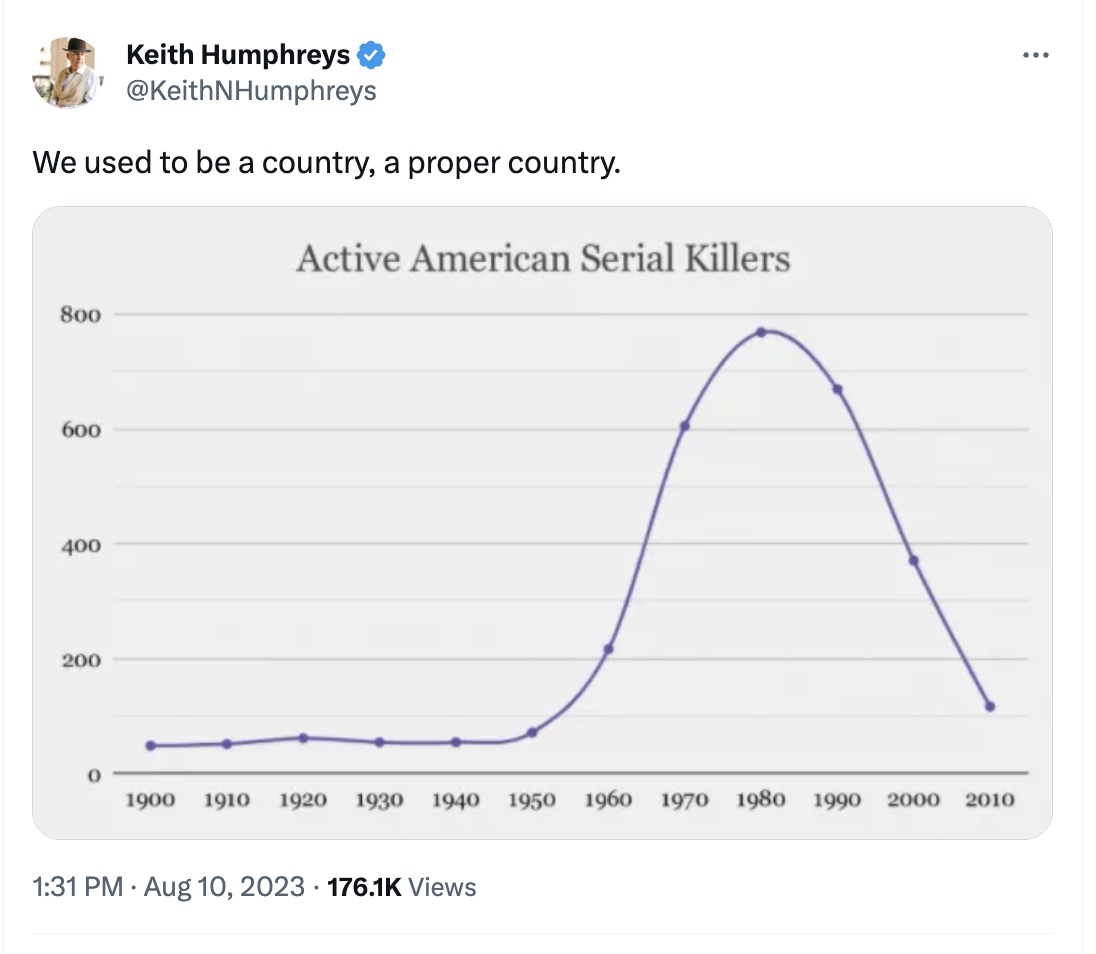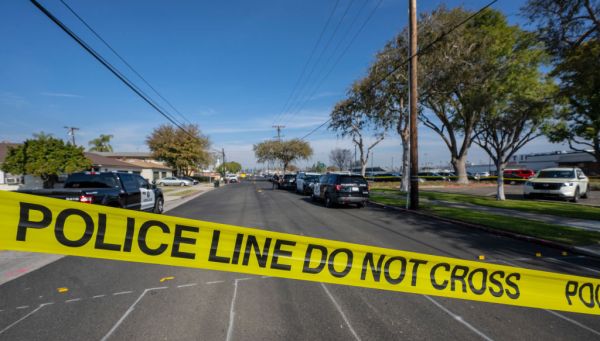This newsletter has spent too much time lately on the state of Ron DeSantis’ presidential campaign. Topical though it may be, it’s relentlessly dreary fare for a fun summer month like August. We should spend Friday discussing a subject that isn’t as grim.
Let’s talk about serial murder.
I’m a true crime junkie, a habit to which I was driven by the professional demands of my last job. I wrote twice as many words daily in that gig as I write for The Dispatch, if you can imagine it, and on six or seven topics each day instead of one. By the end of a 12-hour shift, I felt like an overheated CPU. There was no mental energy left to engage with television programming that was the least bit challenging.
Thank heaven for true crime TV, which isn’t the least bit challenging.
With few exceptions, no matter which series you’re watching, each episode is a self-contained mystery wrapped up in a bow. Some programs even shave the typical hourlong running time down to 30 minutes, making them perfect bite-sized diversions for the frazzled viewer with a badly impaired attention span. If you’re new to the genre I recommend starting with Forensic Files reruns, which are old but timeless and air constantly on HLN. Now and then a young, brunette Trey Gowdy will make a cameo to reminisce about the many miscreants he prosecuted in Spartanburg County, South Carolina.
Sooner than you think, you’ll be discoursing on the miracle of PCR and side-eyeing ignoramuses who don’t know AFIS from CODIS.
True crime is on my mind today because this tweet has caught the interest of some of the people I follow on The App Formerly Known As Twitter.

Most reactions to it follow the same two steps. Is that graph even real? And: It really does feel like there are far fewer serial killers nowadays.
The graph is real. It’s based on data from “the Largest Non-governmental Serial Murderer Database in the World” administered by Radford and Florida Gulf Coast Universities. Discover magazine published it last year.
And yes, although serial killers are very much still around, it does feel like there are far fewer of them nowadays. Why?
Come, navel-gaze with me.
“Where’d all the serial killers go?” is an old-ish topic in American media. It bubbles up whenever we’re reminded that serial murderers haven’t gone extinct, as happened recently on Long Island. They walk among us—but, to all appearances, in smaller numbers than they used to.
If you had to name a serial killer at random, you’d almost certainly point to someone whose rampage took place in the 1970s or 1980s. Bundy, Gacy, Dahmer: I don’t need to provide their first names because you know them. Asked to name a serial killer besides those three, chances are you’d still reach back to that era for your answer. The Night Stalker? The Green River Killer? The Golden State Killer? BTK?
All 1970s and 1980s.
That the supply of murderous degenerates might decline precipitously with time is so confounding that some reject the premise entirely. For instance, one theory holds that the supply of would-be serial killers has held steady but that, in 2023, they’re channeling their homicidal impulses into mass shootings instead. That would be plausible, I think, if serial killers were motivated chiefly by the thrill of racking up a body count. Certainly, shooting up a mall is a more efficient way to do that than staging numerous risky abductions over the span of years.
But (in my amateur understanding) that’s not what motivates them. Serial killers tend to be sexual sadists who relish controlling and tormenting their victims. They don’t want to get caught, let alone risk being killed in a shootout. They hope to remain free to gratify their impulses for as long as possible. A nihilist who’s fantasizing about slaughtering a bunch of people at the mall and willing to risk being gunned down by police to do it is a different animal. Frustration and self-pity for their perceived lot in life seems to be what motivates mass shooters. They feel powerless professionally, romantically, or what have you, so they resort to the most wantonly destructive act they can think of to assert their power. For the sake of saying “I matter,” they’re prepared to kill and die.
I doubt Ted Bundy had any trouble believing that he “mattered.”
A more convincing read on the graph above alleges that there aren’t fewer serial killers, there are fewer known serial killers. The Bundys and Gacys are still out there, hacking their way across America. We just haven’t found them out yet because they’re reeeeeally good at not leaving evidence at the crime scene. As law enforcement has gotten better at detecting crime, this theory goes, the most depraved sociopaths in society have refined their methods to make themselves less detectable. It’ll be years before we develop the means to sniff them out, just as it was years before the killers of the ‘70s and ‘80s were pinched.
As it turns out, modern law enforcement is solving a smaller share of murder cases than it used to. Gulp.
Even so, I find it unlikely that there are as many serial killers today as there used to be. The decline in the graph is real, I suspect, and spectacular.
There may be just as many people in 2023 as there were 50 years ago who are capable of being serial killers but who, for a variety of reasons, aren’t closing the deal. Although I’m inclined to go further—we’re probably not even producing as many would-be Bundys and Gacys as we used to, I suspect.
How has America become less prone to serial murder? Let us count the ways.
Better technology.
There are fewer serial killers in our age for the same reason there are fewer air disasters. As technology has improved, the pros have gotten better at averting catastrophes.
Believe it or not, dear reader, when I was a child it wasn’t freakishly uncommon for jumbo jets to crash, killing hundreds of people. In 2023, it’s almost unheard of. Better engineering and redundant safety systems have made commercial flights not quite crash-proof but mercifully close.
Modern America isn’t serial-killer-proof but we’ve gotten closer.
There’s the science of DNA, of course, which is just 40 or so years old as a forensic tool and is still being refined in ever more impressive ways. Ask the Golden State Killer, who’s sitting in prison today thanks to the developing field of “genetic genealogy.” We can only guess how many recent aspiring serial murderers were caught and convicted after their first crime thanks to DNA evidence, thwarting the sort of killing spree that made Ted Bundy infamous.
It’s not just DNA. Conveniently for the cops, practically everyone in the United States now carries a little device with them at all times that tracks their location. (You’d be amazed at how often murderers profiled on true crime shows got pinched because they stupidly brought their smartphones to the scene and/or texted a co-conspirator about the deed.) Cameras are everywhere, from business storefronts to police CCTV to those same little devices that everyone’s carrying around. Your chances of being recorded while abducting someone are vastly greater than they used to be.
And then there’s AFIS and CODIS, the national fingerprint and DNA databases, respectively.
A recurring problem in serial killer investigations years ago was that police departments in different jurisdictions weren’t coordinating. And not just in different states but sometimes in different counties: Often the cops in one city wouldn’t know that the same type of murder had been committed in another a half-hour away.
That probably explains why there are so “few” serial killers in the graph up top before 1960. It’s not that America’s homicidal maniacs were less apt to act on their impulses before then; in all probability, it’s that many serial killers were itinerant and their body counts remained unknown because the local cops at each point during their travels weren’t talking to each other.
With AFIS and CODIS, among other tools, police across the country are now working off the same information.
Even home security systems have improved since the age of Bundy and Gacy. How many break-ins that might otherwise have ended in murder years ago were interrupted when the intruder heard an alarm and turned tail?
If all of that sounds too high-tech, there’s also a low-tech contributor to the trend: Prison. Parole policies got stricter over time, which meant fewer killers were being freed to kill again. Longer sentences means fewer opportunities to murder.
Better behavior.
Some technology makes us better at detecting crimes after they’ve occurred. Other technology makes us better at diverting people from committing crimes in the first place.
At least one study has shown that killers have less gray matter in areas of their brains responsible for social cognition and controlling their behavior than other criminals. It’s not unusual in the true crime genre to learn that a killer suffered a traumatic brain injury, in fact; I remember one case in which a baby who grew up to be a serial arsonist had been born with his umbilical cord wrapped around his neck, cutting off his air supply and causing some brain damage. To the extent some murderers are products of accidents or medical mishaps, it stands to reason that we’ll see fewer of them as medicine and safety technology get better over time.
For instance, how many people with criminal tendencies have had their worst impulses blunted by pharmaceuticals that weren’t available in the, ahem, “golden age of serial killers”?
For that matter, how many modern sexual sadists who would have turned to crime to gratify their urges in an earlier era have used online pornography to scratch their itch instead?
The “more porn, less crime” hypothesis is controversial for obvious reasons, because it imagines ubiquitous access to degradation as a moral good in some sense. Keeping society’s most violent perverts well fed with virtual deviancy isn’t anyone’s idea of “progress.” But it may be, as an empirical matter, that some of those perverts who are inclined to kill have been diverted by porn into less destructive forms of perversion. We don’t need to call that “progress” to say that it’s preferable to the alternative.
My favorite theory of better behavior through better technology, though, comes from a piece Kevin Drum wrote in 2013. Why had crime dropped so sharply in so many different jurisdictions over the previous 20 years, Drum wondered? Could the answer be as simple as … lead?
A … study found that high exposure to lead during childhood was linked to a permanent loss of gray matter in the prefrontal cortex—a part of the brain associated with aggression control as well as what psychologists call “executive functions”: emotional regulation, impulse control, attention, verbal reasoning, and mental flexibility. One way to understand this, says Kim Cecil, another member of the Cincinnati team, is that lead affects precisely the areas of the brain “that make us most human.”
As the amount of lead in gasoline fell over time, crime fell with it. Lead won’t turn a normal person into Ted Bundy, of course, but how about an abnormal person who’s not yet quite so abnormal that he’s prepared to murder 30 women? Might exposure over time to a toxin known to shrink gray matter tip someone like him over the edge?
How’s that for a slogan for the Green Party next year? End serial killing: Save the environment.
Better awareness.
There’s no problem in life that can’t be addressed more effectively with better information. Our information about serial killers is much better than it used to be.
Everyone knows about the FBI’s Behavioral Science Unit, which began (when else?) in the 1970s and within a few years was consumed with profiling serial predators. Profiling is more art than science but it can be useful. In one old murder case I heard of, local cops marveled that a profile created for them by an FBI agent matched the killer so closely that it predicted not just the make and model but the color of his car. It’s another law enforcement tool that, in some instances, might help catch fledgling murderers before they turn serial.
Catching killers after the fact, before they can kill again, is nice, but denying them access to potential victims before they kill for the first time is better. Public awareness of how serial predators operate is likely higher today than it’s ever been—in part because of the explosion in true crime media content that often glamorizes the subject, ironically.
If you suggested to a young American woman 50 years ago that she should hitchhike to get where she’s going, she might or might not sound receptive. Propose the same idea to a young American woman in 2023 and see how receptive she is. We’ve all seen that movie, or watched that television show, or listened to that podcast by now. We know how it ends.
There are a lot of sickos out there. Today’s women know it—they’ve been on dating apps—and so, I suspect, they behave more cautiously on average than women did before serial killers were household names. For an aspiring murderer, the pickings aren’t as easy as they used to be.
Children are also harder targets in some ways.
Conservatives like to complain that parents don’t give their kids enough independence. Years ago a child would be allowed to walk to and from school alone and to play with friends unsupervised; helicopter parenting has led to a coddled generation that’s constantly looking to mommy and daddy for guidance. It’s a fair point, but one benefit of having mom and dad forever in tow is that the local degenerate scouting out the playground has no opportunity to scoop up a child and abscond with them. “The predator starves when prey [is] scarce.”
It may also be that as social awareness of how criminals operate has grown, so has awareness of how a child’s upbringing might lead them toward antisocial behavior later.
Violent criminals often point to harrowing episodes from their childhood to explain why they did what they did when pleading for leniency during sentencing. Social services in the 1950s and 1960s, when many noted serial killers were coming of age, surely weren’t as robust and as sensitive to the effects of household abuse on children as they are now. In my own lifetime, awareness of how sexual abuse causes enduring trauma to kids has grown enormously. Insofar as the modern state is intervening sooner to rescue children from abuse and treating them more thoughtfully for their trauma with therapy, their behavior as adults may be less destructive than it would have been in an earlier era.
Put all of the above together and it seems likely to me that there are fewer serial killers around than there once were. That’s the good news. Less good is the fact that, per the Radford/FGCU database, a solid 67 percent of all known global serial murderers since 1900 have been Americans. I assume that number is mostly an artifact of detection, not culture—i.e. we’re simply sniffing out our Bundys and Gacys more efficiently than other countries are sniffing out theirs. But you never know: America has also reported vastly more UFO sightings than any other country in the world. We’re a weird bunch.
Hopefully the serial killers of tomorrow will take that under advisement, though. If you want to kill with impunity, you’re almost certainly less likely to be discovered doing so abroad than you are here. A safer America through emigration!









Please note that we at The Dispatch hold ourselves, our work, and our commenters to a higher standard than other places on the internet. We welcome comments that foster genuine debate or discussion—including comments critical of us or our work—but responses that include ad hominem attacks on fellow Dispatch members or are intended to stoke fear and anger may be moderated.